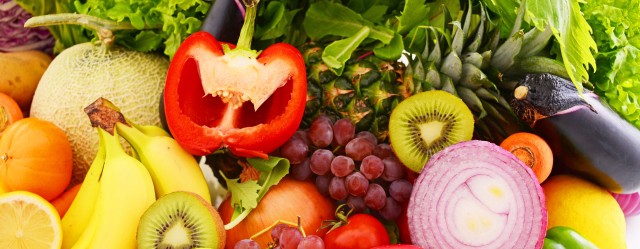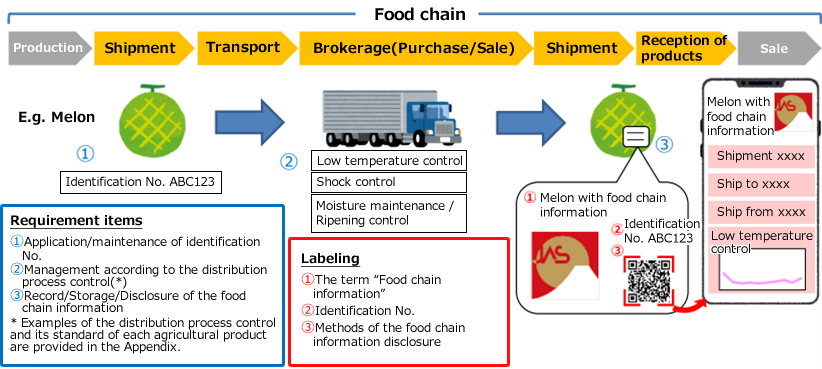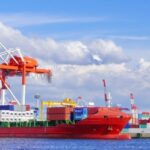
The Japanese Agricultural Standards (JAS) for agricultural products with food chain information was enacted on March 30, 2023 and came into effect on April 29, 2023.
Background
Establishing the Smart Food Chain Platform (SFP), which is a platform for linking a series of data on agricultural products from production to sales, enables the setting of this JAS. The aim of setting up the JAS is to strengthen the competitiveness of agricultural products, including in overseas markets. While the JAS for the production processes, such as for the Organic products and for the Production details have already been set up, it is the first time that a standard that covers the distribution processes after production has been set up.
The target agricultural products and the food chain information to be indicated
Currently the distribution process control standards for three products, “Lettuce”, “Melon” and “Grape”, have been set up.
| Food item | Control items | Distribution process control standard (outline) |
|---|---|---|
| Lettuce | Precooling / Low temperature control | Before shipment: Core temperature (0-10℃) Distribution process: Setting and control of temperature for delivery and storage *1 |
| Harvested in the morning | Harvest time: From 12:00 a.m. to 9:00 a.m. Sales: Until the end of the day of harvest |
|
| Melon | Low temperature control | Distribution process: Setting and control of temperature for delivery and storage *1 |
| Shock control | Before shipment: Application of cushioning materials designed and proven to absorb shock to the bottom of the shipping boxes | |
| Moisture maintenance and ripening control | Distribution process: Setting and control of the conditions for moisture maintenance and ripening control *2 | |
| Grape | Low temperature control | Distribution process: Setting and control of temperature for delivery and storage*1 |
| Shock control | Before shipment: Application of cushioning materials designed and proven to absorb shock to the bottom of the shipping boxes (Setting and control of the maximum allowable shocks and their frequency if a cushioning material is not applied) Before shipment: Application of cushioning materials for fruits |
|
| Moisture maintenance and anti-mold treatment control | Distribution process: Setting and control of the conditions for moisture maintenance and anti-mold treatment*2 |
*1 Setting and control for allowable temperature and allowable storage time in situations where low temperature cannot be controlled.
*2 In the cases where the distribution process takes more than 3 days for shipment to the retail store.
After those requirements are met, the necessary labeling (see the figure below for the requirements and labeling) will be made. One of the characteristics is the use of external media such as HP addresses and QR codes and so on for food chain information.

(Quoted from the public comment materials Ministerial Ordinance for Partial Revision of the Ordinance for Enforcement of the Act on Japanese Agricultural Standards)
Summary
At present, only three agricultural products – lettuce, melon, and grape – are subject to the standards, but the expansion of the scope to other agricultural products such as strawberries is expected. The Food Labeling Standards do not address the labeling for these agricultural products with food chain information when they are used as ingredients in processed foods at present. However, the Food Labeling Standards have the labeling rules for other JAS products such as organic to indicate as “special ingredients”. So, it is anticipated that there may be a future consideration to include rules for the labeling of agricultural products with food chain information in the Food Labeling Standards.
Share/Like/Follow:
Newsletter Signup
We issue monthly e-newsletters, which provide you with the latest updates on food labeling/regulations in Japan.
If you want to make sure to not miss any issue, please click below.
Related Service
Research Services on Ingredients & Food Labeling -For the Japanese Market-
We verify the conformity of ingredients and additives with the standards for use in Japan based on specifications such as formulation lists. We also verify the conformity of the proposed labeling of ingredient names, nutrients, etc. with the labeling standards based on specifications such as formulation lists.

Label bank Co., Ltd. Regulatory Review and Development
Born in Japan. Specializing in biochemistry, he is engaged in research work on ingredients and additives imported to Japan from overseas, and provides consulting services on food standards, additives, and food labeling.






